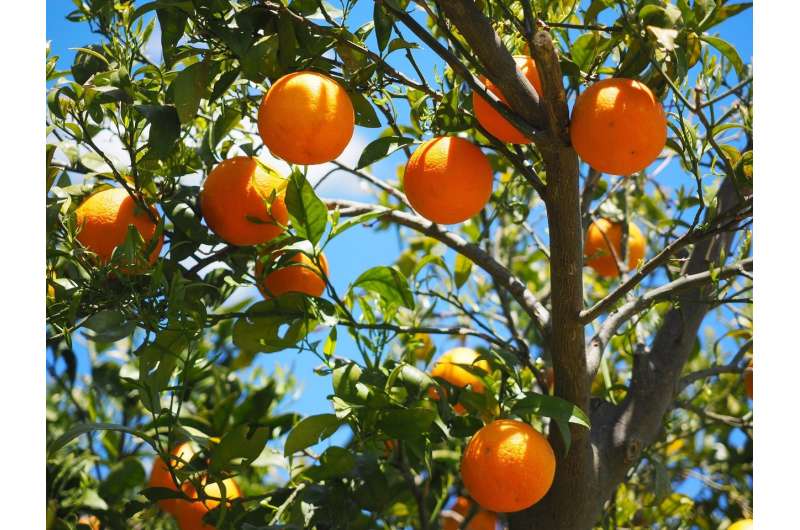This article has been reviewed according to Science X's editorial process and policies. Editors have highlighted the following attributes while ensuring the content's credibility:
fact-checked
peer-reviewed publication
trusted source
proofread
Nutrient uptake in citrus rootstock affected by huanglongbing

Huanglongbing (HLB) is presumably caused by the phloem-limited bacteria, Candidatus Liberibacter asiaticus (CLas), and is one of the most devastating diseases of citrus. A distinctive chlorotic mottle on fully expanded leaves is one of the identifying symptoms of HLB.
Currently, there is no cure for HLB, and there is no commercial HLB-resistant germplasm. However, it is well known that HLB-affected citrus trees receiving complete and balanced nutrition perform better over time, and intensive nutrient management has been promising for citrus growers Field surveys have shown that HLB-affected trees can remain productive for longer durations when provided with nutrients [such as Mn, Zn, Fe, boron (B), Ca, Mg] at higher levels than those recommended for healthy citrus.
By understanding the nutrient uptake potential of rootstocks, fertilizer programs can be customized accordingly to enhance the performance of a rootstock in existing groves. Moreover, a reduction in the application of nutrients is possible by planting rootstocks with a high nutrient absorption capacity. Use of rootstocks with good nutrient uptake efficiency can take some burden off the growers who are intensively managing HLB-affected citrus groves.
The objective of a new study published in HortScience was to evaluate and understand the nutrient uptake potential of the citrus rootstocks. This study is unique because it is one of the first citrus studies to report nutrient uptake efficiency and the potential of rootstocks. The information presented can be used to improve performance or select better-performing rootstocks under HLB conditions.
This study, the first of its kind involving citrus, lays the foundation for studying nutrient uptake differences among different rootstocks. Field validation is still required to strengthen the results because this was a potted hydroponic experiment. Nevertheless, the research team demonstrated that the rootstocks should be selected after considering the soil nutrient status and equally emphasizing the nutrient uptake potential and absorption efficiency of roots.
According to researcher Dr. Tripti Vashisth, "This study was undertaken as we learn that enhanced plant nutrition can improve the productivity of HLB-affected citrus trees. Several new citrus rootstocks have been introduced to Florida citrus growers in the last decade; however not much is known about them. Therefore, with this research, we were aiming to understand if rootstocks differ in nutrient uptake, if so then growers need to customize fertilization program based on rootstock. Moreover, rootstocks with high nutrient uptake may have higher tolerance to HLB."
The primary scientist on this study was Lushan Ghimire, Ph.D. student in blueberry breeding at the University of Florida.
Dr. Tripti Vashisth is Associate Professor and Citrus Extension Specialist at the University of Florida. Her research focuses on nutrition and plant growth regulators to improve the productivity of citrus trees.
More information: Lushan Ghimire et al, Differences in Nutrient Uptake Can Influence the Performance of Citrus Rootstocks under Huanglongbing Conditions, HortScience (2022). DOI: 10.21273/HORTSCI16753-22
Journal information: HortScience
Provided by American Society for Horticultural Science



















